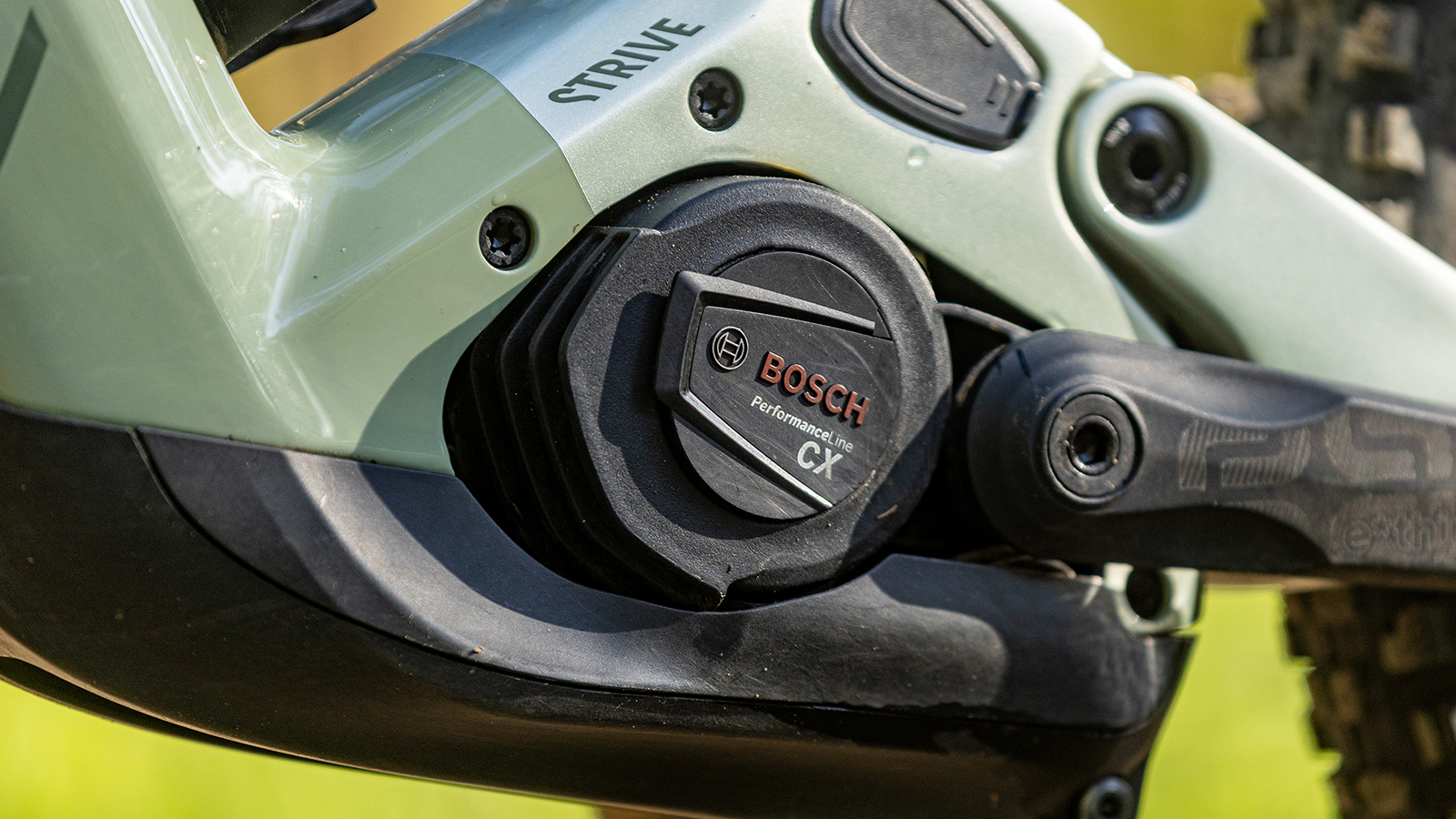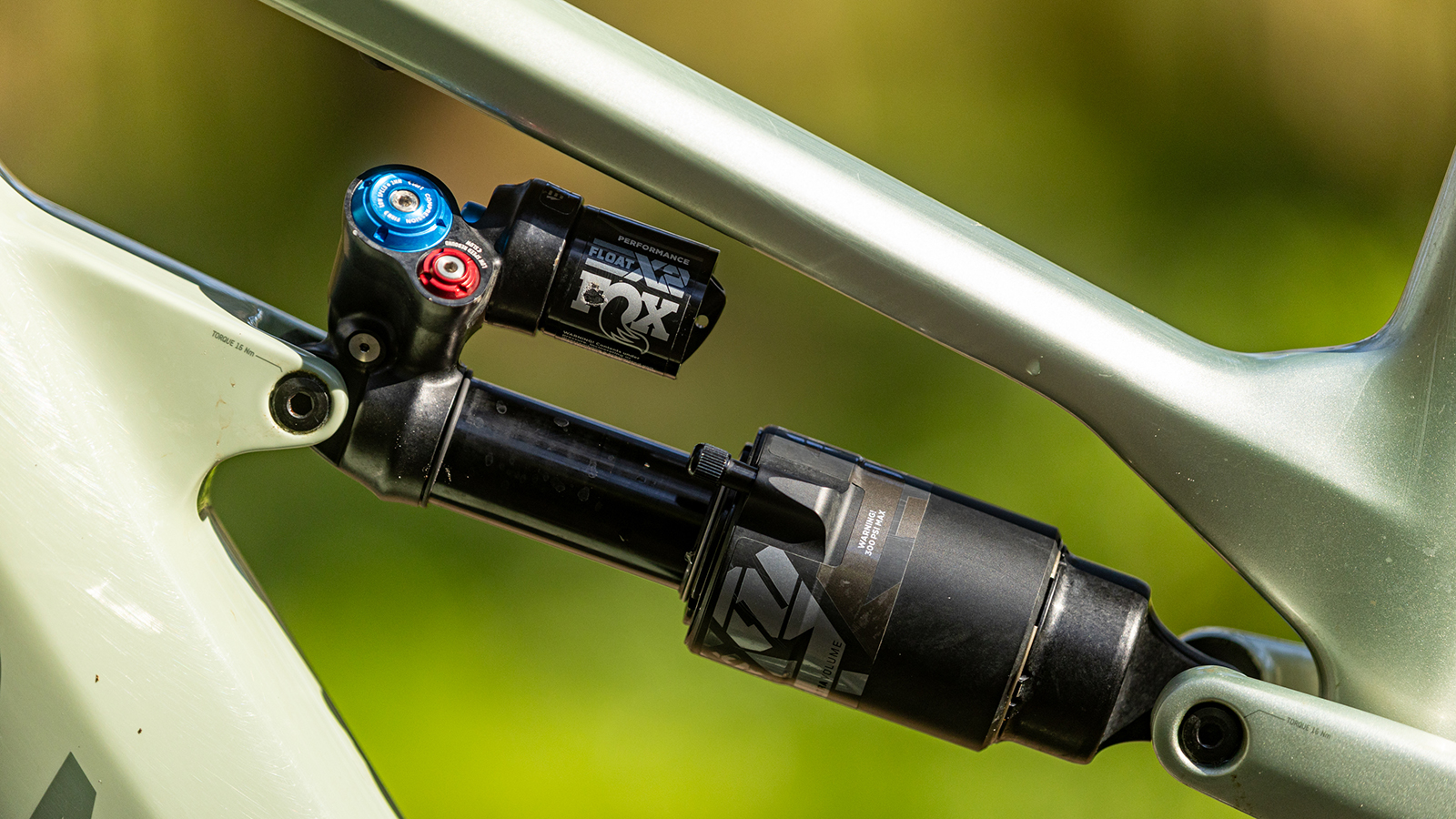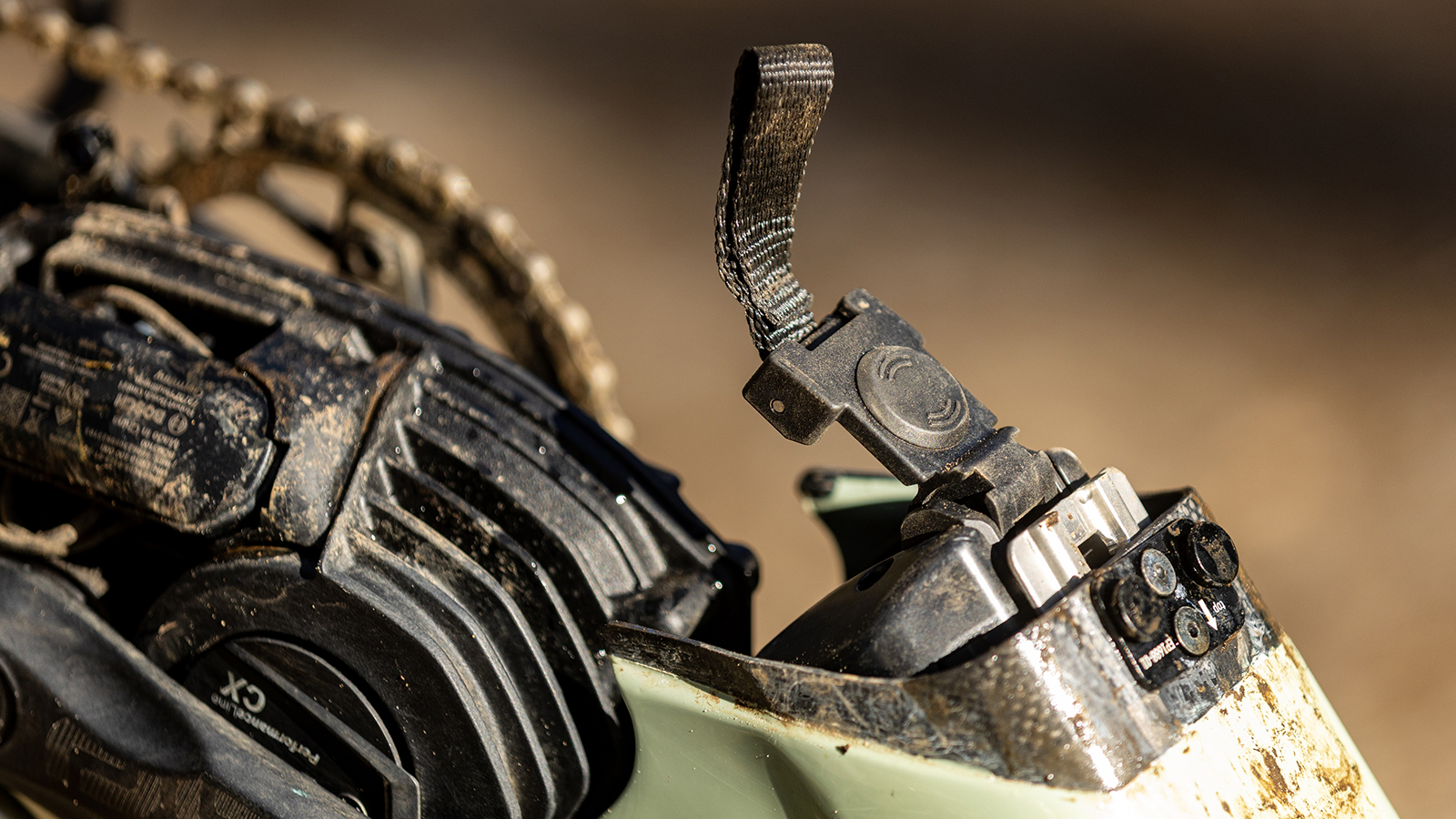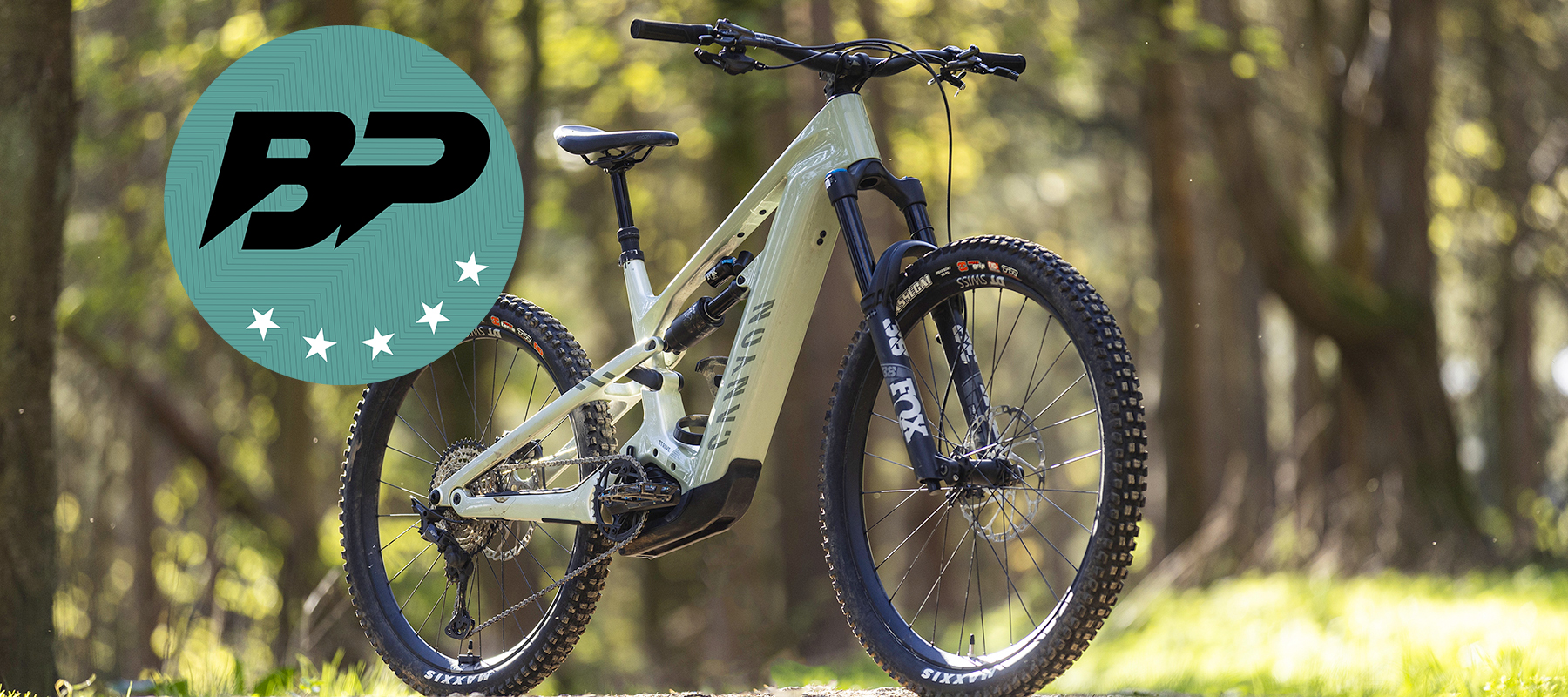Bike Perfect Verdict
I recently awarded the Strive:ON’s longer-travel big brother Torque:ON full marks for my first time ever on Bike Perfect. Well, Canyon has only gone and done it again, and if anything excelled itself here with a hard-to-fault 160mm e-bike package that now comes with a hefty price reduction to make it even better value.
Pros
- +
Superbly balanced handling and smooth ride quality
- +
Engaging, lively and responsive without ever biting back if you play too hard
- +
Bosch motor packs a proper power punch
- +
Huge distance and climbing range
- +
Removable to charge indoors 750Wh battery
- +
Beautiful finish and superb components for the cash
- +
Light-ish for a full fat e-enduro bike
Cons
- -
The gaps between frame sizes are quite large in the middle of the range most male riders will fall into
- -
Canyon dropper post developed significant side-to-side play
- -
Cheaper Shimano Deore chain rusts too easily in wet conditions
Why trust BikePerfect
This full carbon Bosch CX Strive:ON is one of a pair of long-travel gravity-focused Canyon e-bikes. The other is the superb 5/5 scoring Torque:ON I reviewed recently with 15mm more rear travel, a 10mm longer travel fork and a Shimano motor powered by a whopping 900Wh battery.
Both roll on MX wheels, but Canyon isn’t just mindlessly filling in gaps in a theoretical travel range where each bike just has different amounts of travel and motors. On the contrary, each has its own completely unique frame shape and suspension layout, and perhaps more importantly, individual intention and character.
The days when direct sales outfits like Canyon were playing catch-up with established big brands are long gone and the Germans are now major innovators in terms of bike tech and detailing. The engineering team designed the longer travel Torque:ON more as a pure gravity DH shuttle for bike park smashing and ‘super-enduro’, whereas this Strive:ON is optimized for enduro racing and developed directly with input from World EDR-E champion, Fabien Barel, and the Canyon Factory Racing team.
That brief summary of each bike’s overall flavor is obviously not to say there isn’t more than a slight overlap in what each can do considering they share ballpark geometry and travel numbers. To start with, the higher-spec (pricier) Torque:ON CF9 I tested is actually a kilo lighter than this Strive:ON CFR and so agile and reactive, it’s perfectly at home on mellower tracks and flowier trails – so long as there is gravity on your side.
And, on the flipside, this Strive:ON is clearly not exactly shy when it comes to devouring the hardest tracks around, as Monsieur Barel isn’t winning EDR-E DH stages in ski resorts by tidy margins if Canyon’s 160mm e-bike can’t excel when being absolutely hammered down mountains by an ex-DH World Champion.
So, we’ve established Canyon is clearly doing its hauswerk on these e-bikes, but which model will shine for most riders, and what are the main differences that make this excellent value Strive:ON stand out from the rest of the e-enduro crowd in its own right?

Design and geometry
Smooth-lined and contemporary looking, Canyon’s rig has a familiar 4-bar silhouette with shock underneath the top tube and in line with stays. It bears more than a passing resemblance to YT’s Decoy, but look deeper and there are some subtle differences.
Canyon doesn’t just use any old carbon to bake into the Strive:ON; the frame uses stronger, pricier carbon fibers laid up in fewer layers to save weight, and these are precisely laid down in the chassis to custom-tune for the flex characteristic and tracking quality the brand and its EDR racers demanded. The whole chassis is claimed to weigh 3.26kg in the Medium size I tested, and beautifully finished with tidy touches throughout and smooth edges on outer surfaces. Out of view, there are plenty more details hidden, including a special proprietary mount system for the Bosch Powertube battery and special frame hardware.
Riders can choose a 750Wh (£200 more at checkout) or 625Wh lithium battery, depending on whether they prioritize weight saving or range. The frame houses the battery cleanly inside the downtube on rails that save over 300g over Bosch’s own solution, and where the battery slides in there is a very chunky skid plate under its tail and the drive unit for bash protection.
With the battery fully hidden like this, the downtube can form one continuous carbon section, which saves weight and makes for a stronger structure. The use of carbon also allows integrating the Bosch CX display into the top tube with its battery life and power mode information very neatly. It looks slick, but the major plus for me is it also means Canyon can use a simple push-button Mini Remote bar controller that takes up minimal handlebar real estate and can’t get damaged too easily like the bulky Kiox displays on alloy Bosch rigs.

There is plenty of protection and rubberized damping on the chainstays to quieten the ride, and seeing as the Strive originates from the same template as the Sender DH bike, the frame also uses replaceable thread inserts and double-sealed bearings that Canyon pumps extra grease into to last longer without maintenance.
The suspension layout looks more like a Spectral than the Torque with the shock in line with stays and anchored to the top side of the downtube. There is still room underneath for a full-size water bottle (rather than the Torque’s funky petrol tank effect) and also frame storage bolts for stashing extra kit under the top tube in front of the shock reservoir.
The geometry is slack without being too radical with great standover clearance and, while the seat tube angle is plenty steep at almost 79-degrees, it never feels like it puts excessive weight on your hands on flatter or more rolling terrain.
Canyon offers four sizes, although there is a significant gap between the 475mm reach on size Large to the 500mm reach on size XL in the zone where the majority of male riders will fall. At 176cm I was bang on for the Medium, but if you are 180-190cm it might be a bit of a gamble on which size to go for.
Chainstays aren’t size-specific like some bikes, but at 445mm they are on the shorter side for an e-bike, which helps keep the handling dynamic and lively. It’s pretty easy to manual the Strive:ON, or if you skills aren’t as advanced, this also translates to being easy to lift the front wheel up to clear obstacles and big square edges rather than stoving a full fat e-bike and your worth of weight into them.

Components and build
For this much money (especially now that Vitus is out of the running), you can’t really do better for kit and components than that which Canyon is offering. For five and a half grand with a motor that’s regarded as the best in the business, the build here is pretty special.
Throughout the parts, it’s not just ‘name’ kit with no thought behind it – there are all the right choices throughout and no duff bits you need to swap out except maybe Canyon’s slightly thin and less comfy own brand grips.

The Fox 38 fork and X2 shock are very adjustable and totally dialed and DT Swiss e-bike rated wheels with a ratchet freehub can handle higher e-bike torques and are proven tough enough to handle heavy e-bike impacts. The Maxxis Assegai/Minion DHR II combo is pretty much an industry-standard in terms of grip, although some riders might prefer to run more protective full-on dual-ply DH casings if they live somewhere very pointy.
The Shimano drivetrain and brakes with big 220/203mm rotors are also well sorted and there are little signs of corner-cutting with sneaky lesser quality bits where it’s less visible, although some SLX and Deore creeps into the mostly XT level kit. While the cheaper SLX cassette is fine, the Deore chain rusts far too easily in winter conditions (even on the way back from muddy rides) and Canyon’s adjustable G5 dropper also developed considerable side-to-side flop over the course of testing.

Motor and battery
As mentioned in the intro, even though this Strive:ON is pretty light at 24.2kg with a 750Wh battery, it’s actually heavier than Canyon’s Torque:ON with a 900Wh battery. In part, that’s down to a few grams here and there in the Torque’s pricier componentry, but also because Shimano’s EP801 is one of the lightest full-power motors on the market (2.7kg versus 2.9kg for CX).
Both Bosch and Shimano drive units claim 600w peak power and 85Nm of torque, but the general consensus is CX just has the edge in terms of sheer grunt. It also has more tunabilty, overrun and extra pull at lower cadences. A main reason CFR chooses Bosch to race with though is that the brand also offers an even pokier Race motor that’s in the most expensive RockShox-clad Strive:ON LTD Edition race replica.
This magnesium-cased CX Race is 150g lighter and packs 400 percent, rather than 340 percent, assistance and crucially a two-meter overrun feature that is a bit of a secret weapon for the EDR climbing stages because it allows cresting steps and ledges without catching cranks.
Bosch has a well-earned reputation as being one of the most reliable motors on the market and in my experience, its products seem to cope best with continuously wet and muddy conditions (like the UK and Canada) that have been notorious for killing Shimano drive systems prematurely.
To be fair, however, Shimano is fast catching up and the latest EP801 is far more reliable than previously and also has the significant advantage of allowing brands to use proprietary third-party battery solutions. This means Canyon can use a 900Wh battery on its Spectral and Torque, yet be limited by Bosch’s maximum 750Wh Powertube size here. This battery/motor package is a complex area of comparison, range and usable power, so I’m going to write a separate feature shortly about my experiences comparing the two motors directly.
Sticking with the Bosch system here, some early Strive:ON owners had issues with the metal latch that secures the Powertube battery inside the downtube not being secure enough and power cutting off on rough descents. Canyon has tweaked the design now though and I had zero problems so long as you ensure the metal latch is properly hooked before you reinstall the beefy plastic skid plate that protects the whole of the bottom of the bike.
Extra little Strive:ON motor details include a valve stem speed sensor magnet that talks to the drive unit and eliminates the need for extra wires down the chainstay, and the minimal push button bar remote already mentioned that’s one of the cleanest solutions of any brand’s system for switching modes. Riders can also cycle settings on the top tube controller which has five light blocks – each with two colors – for a battery life readout that is way more accurate than Shimano’s vague display.

Ride, handling and performance
From the very first ride, I felt perfectly at home on the Strive:ON. The rider position is perfect between each wheel and it’s a world away from some unrefined e-bike tanks with similar travel that just plough and smash through terrain and feel constantly glued to the floor.
Instead, this Canyon manages to be incredibly precise and rapid switching side-to-side and linking trail features, but without any sense of edginess or being overly sharp to catch you out if you’re really pushing on. It’s sort of calm and predictable, but without ever being boring, and with the geometry and suspension so bang-on it simply doesn’t take much effort to feel like you’re absolutely shredding.
Drilling into the suspension, I reckon the key to why it’s so good is the support continuously in the suspension that means there’s a really seamless feel through the stroke. It practically hovers over chatter off the top then there is more and more to push against deeper in the middle. I ended up running it slightly harder with around 25-30 percent sag where the back end feels punchy and supportive while still plenty supple and floaty off the top.
Both the Fox 38 fork and X2 shock work in perfect harmony too and don’t need any special attention to find a sweet spot – I basically twiddled a few dials and set pressure on the first ride and had zero inclination to ever touch it again, which is always the sign of a totally dialed bike to me.
The back end responds well to pumping through hollows to generate speed if you push into the travel. And despite being 24kg, it never feels too heavy and can bounce out of holes and boost jumps and lips, while also feeling simultaneously very delicate and planted on the ground through really rough, beaten-up sections if you ride light and let the bike do its thing and float across the top.
The steering is great too – light yet stable enough and the bike is so well balanced it goes exactly where you want it to with seemingly minimal effort. Everything about the handling feels perfectly dialed wherever you ride it – it never pitches weight too far forward under braking or tucks in at the tail when you haul on the anchors down steeps or slam into massive banked turns. Plus, it’s perfectly comfy climbing up any grade with no wheel wandering or floppiness at the bars. The almost 79-degree seat angle is at the steeper end of modern bikes and I feared it might put pressure on hands on longer rides, but it was never a problem
One thing that really stands out here is how Canyon has done a fantastic job with the frame feel here – there’s a little bit of give and dullness to the chassis without it ever feeling twisty or twangy. This in turn helps add grip and calmness on off-camber dirt or root webs or stump tails without detracting from any of the reactiveness.
The only other e-bike I can think of with such a well-tuned chassis feel and flex characteristic is Specialized’s Turbo Levo MX, but Canyon’s suspension is more nailed down and consistent, the bike stays more balanced in both directions, and components here are way better for a price that’s thousands less too.

This sense of silky smoothness through the frame is one of the key things that sets this Strive apart from the Torque:ON. The Torque feels absolutely rock solid around the head tube and front triangle, which gives that bike a lazer-sharp steering response and it is also slightly more tilted back and DH-orientated with the rider balance slightly more over the back tire.
The Torque:ON not only generally feels a little stiffer and more direct, there’s also a sense that you’re riding lower to the ground with the extra travel, which can feel incredible cranking it over through some corners, but also has the penalty of the cranks getting dangerously close to the floor more often. And, that’s definitely something to be mindful of considering there’s not exactly a high BB on this Strive:ON, either. Even with the Torque:ON having more travel, I’d argue it’s punchier and sharper than the more comfortable Strive:ON and more direct slingshot way cornering than the Strive’s abilty to kind of slink around turns.
One area where the Strive definitely trumps it is when you haven’t got gravity on your side, the Torque can want to fall asleep on mellow trails where you’re not injecting a ton of action. Whereas the Strive:ON is more versatile and perfectly happy mixing it up on more trail bike terrain than just pure DH tracks.
Comparing the two motors, if you crank up the sliders in the Shimano E-Tube app then peak power is so close to Bosch’s even at lower cadences that I don’t reckon it would make much difference to many riders in the real world. The Shimano/Canyon battery setup offers 150Wh more range than the Bosch Powertube, which gives a really meaningful boost to range and ride time with no extra weight penalty. But swapping between this and the 1kg lighter Torque:ON, I’ve no real preference as to which motor is ‘better’. That said, I don’t tend to rely on Boost or Turbo and grind around in too stiff a gear (like a lot of e-bikers judging by cassette wear on cassettes at my mate’s bike shop) where Bosch CX just has the edge.
Overall, I loved the Strive:ON so much I’ve been guiltily riding it again and again knowing full well it was worthy of a top review from the off and needing to move onto other test bikes. It’s one of a handful of e-MTBs that just hits all the right notes and one of the rare ones that you look for every excuse not to hand back at the end of testing.
For the money, the level of performance and parts package is superb and totally ready to race if that’s your thing, or to just muck about on pretty much any kind of trails from blue grade upwards if it isn’t. It’s telling I’ve ridden the Strive:ON way more than the Torque:On where I live with two minute-max enduro style trails. Whether I’d opt for the pure DH vibe of the Torque:ON or the more rounded Strive:ON, would depend mostly on local terrain and access to the kind of trails where the Torque thrives.
Either way, if I was buying an e-bike with my own money I can’t see how I’d look any further than a Canyon and even writing this has got me thinking, 'which one do I prefer?' I do have a soft spot for how much the Torque rips it up and a 900Wh battery can buy you a hell of a big ride if that’s your bag.

Verdict
Ride handling, suspension and balance here are some of the best of any e-bike I’ve ridden and the Strive:ON CFR is a superb all-rounder that excels in a wide range of terrain. The carbon chassis looks great and offers the perfect balance of solid yet comfy and is so easy to ride fast you simply feel like you’re having a good day on every ride.
Whether all this makes it a better complete package than the fire-breathing Torque:ON pretty much depends on whether you have access to serious terrain on your doorstep. I might just prefer the slice through corners, pure DH bike-like handling of that bike for absolutely ripping downhill on and carving up berms and jumps, but the Strive:ON will definitely be a better rounded package for most riders who aren’t fixated on replicating a DH race run from their youth.
Test conditions
- Conditions: All the weather, from bone dry, tire knob-flexing high forces to nasty winter slime and slop
- Terrain: Everything from the steepest and hardest local tracks to Lake District rocky descents and hand-cut berms, jumps and local enduro tracks. Also rode a few trail center sections and bridleways here and there
- Temperature: 0 to 18-degrees C. UK winter/spring temps
Tech specs: Canyon Strive:ON CFR
- Price: $5,799 / £5,449 plus box and shipping (£18.99 and £49.99) = £5,517.98 / €5,749 plus box and shipping (€19.90 and €39.90) = €5,798.80
- Discipline: Trail/enduro
- Frame: Canyon full carbon 160mm travel (Cat 4 rated). Size Medium
- Fork: Fox Performance Elite 38 GRIP2 170mm travel
- Shock: Fox X2 Performance
- Head tube angle: 63.5 degrees
- Seat tube angle: 78 degrees
- Chainstay: 445mm
- Wheelbase: 1,274mm
- Reach: 475mm (large tested)
- Weight: 24.2kg (actual large)
- Drivetrain: Shimano XT mech and shifter, E*13 E-Tech cranks 165mm, Deore SLX cassette, FSA Megatooth 36t chainring, Deore 12-speed chain
- Motor: Bosch Performance Line CX
- Battery: Bosch Powertube 750Wh (625Wh lighter weight option available)
- Brakes: Shimano XT 4-pot. 220mm front and 203mm rear
- Wheels: DT Swiss HX 1700
- Tires: Maxxis Assegai F Maxx Grip EXO+ 29 x 2.5in, Maxxis Minion DHR II Maxx Terra DD 27.5 x 2.4in
- Seatpost: Canyon G5 Dropper
- Saddle: Ergon SM10 e-MTB
- Bars: Canyon Alloy 780mm x 35mm diameter
- Stem: Canyon:ON e-MTB 45 x 35mm
- Rival Products: Canyon Torque:ON, Whyte E-160, YT Decoy MX 4

An ex-elite downhill racer, Mick's been mucking about and occasionally racing mountain bikes for over twenty years. Racing led to photo modelling and testing kit for magazines back in the day, and, nowadays, he's mostly riding enduro-style terrain on conventional and electric bikes. As curious as ever about products and tech, he's as likely to be on the other side of the lens or computer screen rating, reviewing and shooting all the latest gear. Mick's list of regular clients includes Bike Perfect, MBR, MBUK, and most of the leading UK MTB publications at one point or another.

